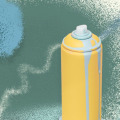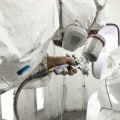If you want to achieve a professional finish with your spray paint projects, it's important to understand the basics of spray painting. Three thin coats are always better than one thick coat, according to Tedesco. This will ensure a smoother finish and help you avoid drops, cracks, and bubbles. Before you start painting, make sure to sand the surface thoroughly to give the paint something to adhere to.
For irregular shapes, a sanding sponge is great for getting into all the nooks and crannies that an electric sander can miss. If you've already used the can, there may be some dry paint on the nozzle which could alter the spray pattern. To prevent this, clean the nozzle after each use by turning the can upside down and spraying until no paint comes out. If you don't mind spending some money, you can also get a special spray protector* that prevents paint from getting everywhere.
Spray Painting Tips and Tricks
Spray painting is a great way to quickly update furniture, crafts, and other items. It usually takes about an hour for the paint to dry between coats, but this can vary depending on temperature, humidity, and brand.To get a lighter color that the paint will cover well, use one or two coats of cheaper primer instead of wasting your good paint in countless coats trying to keep the base from showing. When spray painting, I recommend spraying all the surfaces that are facing up first and then turning them over to the next side so that you can spray the next set of surfaces facing up. Other surfaces such as metal, plastic, and glass have special spray paints that are designed to adhere properly. If you're going to be doing a significant amount of spray painting, it's worth investing in a spray launcher*. This will help you get paint into all the little crevices and it dries quickly so your projects are finished much faster. If you need to spray paint indoors and don't want to paint everywhere, use a box to contain excess paint. The paint spray from a new can is usually more uniform and easier to apply evenly (just be sure to shake it well).
With these tips and tricks in mind, you'll be able to make your spray painting projects more precise and achieve professional results.




Leave a Comment